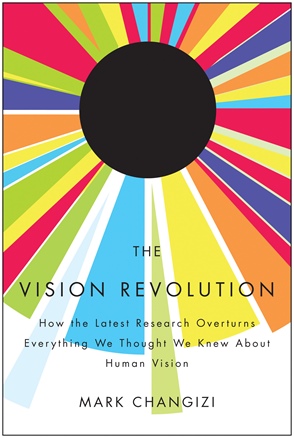Description
In The Vision Revolution: How the Latest Research Overturns Everything We Thought We Knew About Human Vision, Mark Changizi, prominent neuroscientist and vision expert, addresses four areas of human vision and provides explanations for why we have those particular abilities, complete with a number of full-color illustrations to demonstrate his conclusions and to engage the reader. Written for both the casual reader and the science buff hungry for new information, The Vision Revolution is a resource that dispels commonly believed perceptions about sight and offers answers drawn from the field's most recent research.
Changizi focuses on four “why" questions:
1. Why do we see in color?
2. Why do our eyes face forward?
3. Why do we see illusions?
4. Why does reading come so naturally to us?
Why Do We See in Color?
It was commonly believed that color vision evolved to help our primitive ancestors identify ripe fruit. Changizi says we should look closer to home: ourselves. Human color vision evolved to give us greater insights into the mental states and health of other people. People who can see color changes in skin have an advantage over their color-blind counterparts; they can see when people are blushing with embarrassment, purple-faced with exertion or the reddening of rashes. Changizi's research reveals that the cones in our eyes that allow us to see color are exquisitely designed exactly for seeing color changes in the skin. And it's no coincidence that the primates with color vision are the ones with bare spots on their faces and other body parts; Changizi shows that the development of color vision in higher primates closely parallels the loss of facial hair, culminating in the near hairlessness and highly developed color vision of humans.
Why Do Our Eyes Face Forward?
Forward-facing eyes set us apart from most mammals, and there is much dispute as to why we have them. While some speculate that we evolved this feature to give us depth perception available through stereo vision, this type of vision only allows us to see short distances, and we already have other mechanisms that help us to estimate distance. Changizi's research shows that with two forward-facing eyes, primates and humans have an x-ray ability. Specifically, we're able to see through the cluttered leaves of the forest environment in which we evolved. This feature helps primates see their targets in a crowded, encroached environment. To see how this works, hold a finger in front of your eyes. You'll find that you're able to look “through" it, at what is beyond your finger. One of the most amazing feats of two forward-facing eyes? Our views aren't blocked by our noses, beaks, etc.
Why Do We See Illusions?
We evolved to see moving objects, not where they are, but where they are going to be. Without this ability, we couldn't catch a ball because the brain's ability to process visual information isn't fast enough to allow us to put our hands in the right place to intersect for a rapidly approaching baseball. “If our brains simply created a perception of the way the world was at the time light hit the eye, then by the time that perception was elicited—which takes about a tenth of a second for the brain to do—time would have marched on, and the perception would be of the recent past," Changizi explains. Simply put, illusions occur when our brain is tricked into thinking that a stationary two-dimensional picture has an element that is moving. Our brains project the “moving" element into the future and, as a result, we don't see what's on the page, but what our brain thinks will be the case a fraction of a second into the future.
Why Does Reading Come So Naturally to Us?
We can read faster than we can hear, which is odd, considering that reading is relatively recent,
About the Author
Mark Changizi is an assistant professor of cognitive science at Rensselaer Polytechnic Institute. His research areas tend to concern the evolutionary function and design principles governing complex behaviors, perceptions and organisms. His first book appeared in 2003 and is called The Brain from 25,000 Feet: High Level Explorations of Brain Complexity, Perception, Induction and Vagueness (Kluwer Academic, Dordrecht). Dr. Changizi is the first author on 25 journal articles in diverse topics, and his research has been in more than 75 media outlets worldwide, including Time, Newsweek, USA Today, Discover, New Scientist, Financial Times, Daily Telegraph, Scientific American, The Times of London, Natural History, Reuters, ABC News, MSNBC, Fox News, Gehirn & Geist Magazine, Bild der Wissenschaft, Der Standard, Rhein Zeitung, Die Presse, Die Welt, De Morgen, Suddeutsche Zeitung, NRC Handelsblad, Internet Haber, Spiegel and Arzte Zeitung. He has also appeared as a guest on the CBC News As It Happens radio show.
